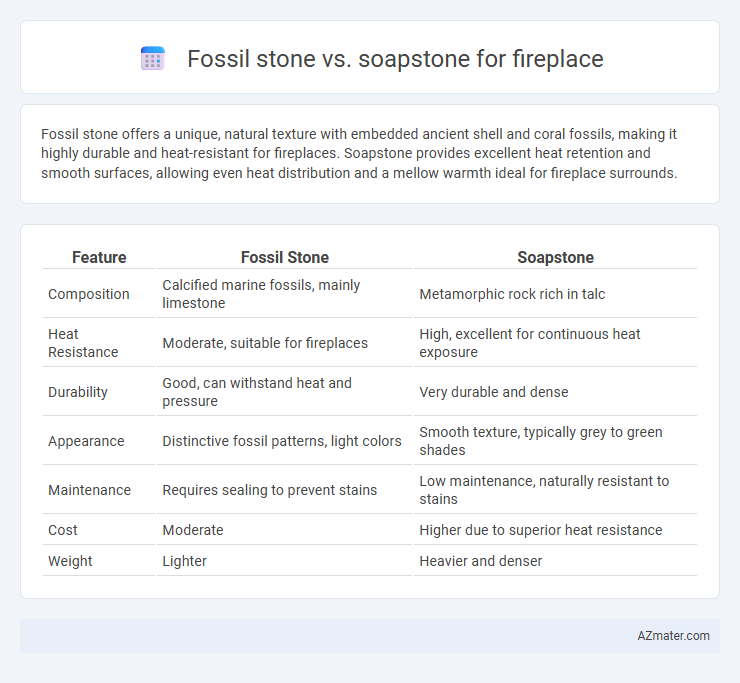Fossil stone offers a unique, natural texture with embedded ancient shell and coral fossils, making it highly durable and heat-resistant for fireplaces. Soapstone provides excellent heat retention and smooth surfaces, allowing even heat distribution and a mellow warmth ideal for fireplace surrounds.
Table of Comparison
| Feature | Fossil Stone | Soapstone |
|---|---|---|
| Composition | Calcified marine fossils, mainly limestone | Metamorphic rock rich in talc |
| Heat Resistance | Moderate, suitable for fireplaces | High, excellent for continuous heat exposure |
| Durability | Good, can withstand heat and pressure | Very durable and dense |
| Appearance | Distinctive fossil patterns, light colors | Smooth texture, typically grey to green shades |
| Maintenance | Requires sealing to prevent stains | Low maintenance, naturally resistant to stains |
| Cost | Moderate | Higher due to superior heat resistance |
| Weight | Lighter | Heavier and denser |
Introduction to Fireplace Stone Materials
Fossil stone and soapstone are popular materials for fireplace surrounds due to their unique characteristics and aesthetic appeal. Fossil stone features embedded ancient marine life fossils, offering a natural, textured look with excellent heat resistance. Soapstone is renowned for its dense, smooth surface, exceptional heat retention, and durability, making it ideal for maintaining warmth long after the fire has died down.
What is Fossil Stone?
Fossil stone is a natural sedimentary rock composed primarily of ancient organic remains, such as shells and marine life, embedded within limestone or sandstone. Its unique texture and durability make it an excellent choice for fireplace surrounds, providing both aesthetic appeal and heat resistance. Compared to soapstone, fossil stone offers a more distinct, fossilized pattern and can withstand higher temperatures without significant wear.
What is Soapstone?
Soapstone is a natural metamorphic rock composed primarily of talc, known for its softness, heat retention, and non-porous properties, making it an excellent choice for fireplaces. It absorbs and radiates heat evenly, providing long-lasting warmth while resisting cracking and staining. Unlike fossil stone, soapstone offers superior thermal durability and requires minimal maintenance, enhancing both functionality and aesthetics in fireplace installations.
Appearance and Aesthetic Appeal
Fossil stone features unique, intricate patterns created by ancient marine fossils, offering a natural, textured look that adds a sophisticated, historic charm to fireplaces. Soapstone presents a smooth, matte surface with subtle veining, creating a soft, contemporary aesthetic that retains heat efficiently and deepens in color over time. Both materials provide distinct visual appeal, with fossil stone emphasizing organic complexity and soapstone offering understated elegance for fireplace design.
Heat Retention and Efficiency
Fossil stone offers superior heat retention due to its dense, mineral-rich composition, allowing fireplaces to radiate warmth over extended periods even after the fire is extinguished. Soapstone, while also excellent at absorbing heat, provides a more gradual release, which enhances overall heating efficiency and prevents rapid cooling in the fireplace area. Both materials improve fireplace performance, but fossil stone excels in prolonged heat retention, whereas soapstone balances efficient heat absorption and steady emission.
Durability and Longevity
Fossil stone offers exceptional durability for fireplaces due to its dense composition and resistance to heat, scratches, and weathering, ensuring long-lasting performance. Soapstone, while slightly softer, excels in heat retention and gradual thermal release, making it highly efficient and durable under frequent temperature changes. Both materials provide longevity, but fossil stone's robustness makes it more suitable for heavy-duty use, whereas soapstone offers sustained heat efficiency with moderate wear over time.
Maintenance and Care Requirements
Fossil stone fireplaces require minimal maintenance due to their dense, durable composition that resists scratches and stains, making them ideal for high-traffic areas. Soapstone, while also durable and heat-resistant, demands regular cleaning with mild soap and water to prevent discoloration and maintain its smooth, matte finish. Both materials benefit from periodic sealing to enhance longevity, but soapstone's softer nature means it is more susceptible to dents and surface wear compared to fossil stone.
Cost Comparison
Fossil stone fireplaces generally cost more due to their unique fossil patterns and limited availability, with prices ranging from $50 to $150 per square foot. Soapstone, known for its heat retention and durability, is typically more affordable, averaging $30 to $60 per square foot. Installation costs for both materials are comparable, but the overall expense favors soapstone for budget-conscious homeowners seeking longevity and aesthetic appeal.
Environmental Impact and Sourcing
Fossil stone extraction often involves extensive quarrying that disrupts ecosystems and produces significant carbon emissions, whereas soapstone is primarily sourced from renewable deposits with lower environmental footprints due to minimal processing requirements. Soapstone's natural heat retention properties reduce the need for excessive fuel consumption in fireplaces, contributing to energy efficiency and sustainability. Choosing soapstone over fossil stone supports responsible sourcing practices and minimizes ecological damage associated with stone harvesting.
Choosing the Best Stone for Your Fireplace
Fossil stone offers exceptional durability and a unique, textured appearance that enhances fireplace aesthetics and withstands high temperatures, making it ideal for long-lasting installations. Soapstone provides superior heat retention and smooth surface qualities, releasing warmth evenly while resisting cracks and stains, perfect for energy-efficient fireplaces. Assessing factors like thermal properties, maintenance requirements, and style preferences helps determine the best stone choice to optimize both performance and visual appeal in your fireplace design.

Infographic: Fossil stone vs Soapstone for Fireplace
 azmater.com
azmater.com